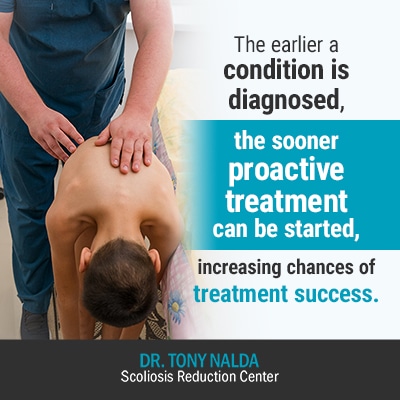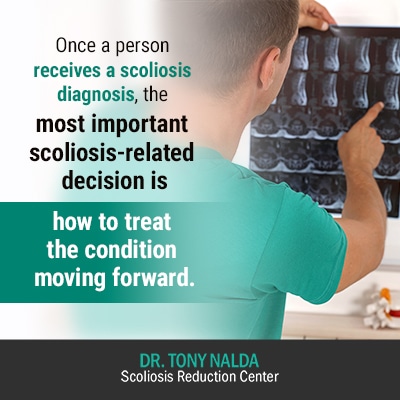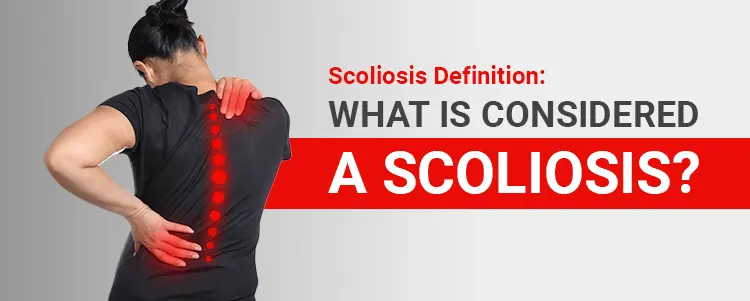There is a difference between what’s known as ‘nonstructural scoliosis’ and ‘structural scoliosis‘. Structural scoliosis is far more common and serious, and within that category, there are multiple different types of scoliosis that can develop. Keep reading to learn about their defining causes and condition characteristics.
There’s a big difference between bad posture that can be corrected with repositioning, and having true scoliosis. For a scoliosis diagnosis to be given, certain parameters have to be met. The spine has to have an abnormal sideways curvature, with rotation, and a minimum Cobb angle measurement of 10 degrees.
Before we start discussing the different types of structural scoliosis a person can develop and their defining characteristics, let’s further explain the difference between nonstructural and structural scoliosis.
Structural vs Nonstructural Scoliosis
For someone who has chronic bad posture, they might wonder if they have scoliosis, but there is a simple way to tell if a person’s postural problems are nonstructural (temporary) or structural (permanent).
Also known as ‘functional scoliosis’, for someone with nonstructural scoliosis, their postural issues are related to a temporary cause and only involves a sideways curvature of the spine, with no spinal rotation.
The spine’s actual structure is still normal in nonstructural scoliosis, and if a person was to bend forward, lie down, or change their position, the curve would likely go away.
A true scoliosis is defined as a structural condition that is progressive, involves a sideways abnormal curvature of the spine, with rotation, meaning the spine both bends and twists, and the curvature has to be of a certain size.
Structural scoliosis is the most common scoliosis category and is far more serious than nonstructural scoliosis. As this type of scoliosis alters the spine’s structure, it’s considered permanent, unless proactive treatment is applied.
Structural scoliosis doesn’t correct on its own with a change in position. It won’t straighten on its own, and as it’s progressive, it will worsen over time, especially if left untreated.
So now that we have defined true scoliosis as a structural condition, let’s talk about the different forms of structural scoliosis a person can develop.
Types of Structural Scoliosis
Before we delve into the different types of structural scoliosis, let’s first expand on the criteria that has to be met to fulfill the definition of structural scoliosis.
In addition to having an abnormal sideways curvature to the spine, it also has to have a rotational component, and a minimum Cobb angle measurement of 10 degrees.
A patient’s Cobb angle is obtained via X-ray and is a measurement taken from the tops and bottoms of the curvature’s most-tilted vertebrae. The intersecting angle is measured in degrees and places the condition on its severity scale of mild, moderate, severe, or very severe.
- Mild scoliosis: Cobb angle measurement of between 10 and 25 degrees
- Moderate scoliosis: Cobb angle measurement of between 25 and 40 degrees
- Severe scoliosis: Cobb angle measurement of 40+ degrees
- Very-severe scoliosis: Cobb angle measurement of 80+ degrees
So if a person has an abnormal sideways spinal curvature that rotates and has a Minimum Cobb angle measurement of 10 degrees, this fulfills the definition of a true structural scoliosis.
Another important piece of condition information I learn from a patient’s first scoliosis X-ray is where along the spine their curvature is located, and in which direction the curve bends.
In typical forms of scoliosis, the curvatures bend to the right, away from the heart; in atypical forms, such as those that develop as a related complication of another medical condition or disease, the curves bend to the left. When I see a curvature bend to the left, I know that it’s going to be a more complex case, one where the underlying cause of the scoliosis development will have to guide the treatment approach.
As mentioned, there are many different types of structural scoliosis a person can develop, so let’s focus on some of the most prevalent forms: idiopathic, degenerative, congenital, neuromuscular, and traumatic.
Idiopathic Scoliosis
Idiopathic scoliosis is the condition’s most common form. In fact, 80 percent of known diagnosed scoliosis cases fall into this category. ‘Idiopathic’ means that there is no single-known cause for the condition’s development.
An important distinction to understand is that just because there is no ‘single’ cause accounting for its development, that doesn’t mean it doesn’t have multiple causes, which is why idiopathic scoliosis is generally thought of as ‘multifactorial’.
While it can be difficult for patients recently diagnosed, and their families, to hear that we simply don’t know why their scoliosis developed, I point out that knowing the condition’s cause wouldn’t necessarily change how the condition is treated, nor how the spine responds to treatment.
Even in idiopathic forms where we don’t fully understand their causation, we most certainly know how to treat the condition effectively so patients can go on to live their best lives, despite having a progressive spinal condition.
The most common form of idiopathic scoliosis is adolescent idiopathic scoliosis (AIS), so let’s start our discussion there.
Adolescent Idiopathic Scoliosis
Adolescent idiopathic scoliosis is the condition’s most prevalent form and is diagnosed between the ages of 10 and 18.
This form can involve rapid-phase progression because growth is the condition’s number-one trigger, and this age group is in, or is entering into, the stage of puberty, characterized by rapid and unpredictable growth spurts.
All forms of scoliosis are progressive, meaning it’s in the condition’s nature to worsen over time, especially if left untreated, but certain forms are more likely to progress, especially in patients who have not yet reached skeletal maturity.

The earlier a condition is diagnosed, the sooner proactive treatment can be started, increasing chances of treatment success.
While no treatment results can ever be guaranteed, if treatment is started early on in a condition’s progressive line, curvatures tend to be smaller, less rigid, less complex, and the body has not yet had time to fully adjust to their presence.
Here at the Scoliosis Reduction Center®, we believe in proactive treatment, and we work towards seeing our adolescent patients through puberty with minimal progression; we do this by monitoring them closely with X-rays and physical exams throughout treatment to see how the spine is responding.
As our treatment plans are 100-percent customized and integrative, we adjust the plan by apportioning different treatment disciplines as needed to help us stay ahead of the patients’ progressive lines.
Idiopathic Scoliosis in Adults
While AIS is the most prevalent form of the condition, adults can experience idiopathic scoliosis as well. While idiopathic scoliosis is the most common type facing adults, these cases are extensions of AIS that were undiagnosed and untreated in adolescence.
While progression still occurs in adult scoliosis, the rates tend to be slower because skeletal maturity has been reached and the trigger of growth has been removed.
It might seem difficult to understand how an adolescent could progress into maturity with a spinal condition unnoticed, but in mild forms, the signs can be very subtle, and in children and adolescents, the condition is rarely painful.
Cases of idiopathic scoliosis in adults are perfect examples of how beneficial early detection can be. Had these adult patients received a diagnosis and treatment during adolescence, their scoliosis would have been treated while the curvature was smaller, less rigid, and before their bodies had adjusted to the curvature.
The other common form affecting adults is degenerative scoliosis, and when adults start to face spinal degeneration, progressive rates can increase.
Degenerative Scoliosis
Degenerative scoliosis, also known as adult ‘de novo’ scoliosis, means the condition has developed fresh in adulthood, with no prior history of having it in adolescence.
This type of scoliosis most commonly affects adults over the age of 40 who are facing the natural degenerative changes associated with aging, in addition to the cumulative effect of certain negative lifestyle choices: not maintaining a healthy weight, leading a sedentary lifestyle, bad posture, and repeatedly lifting heavy objects incorrectly and straining the back.
The spine ages along with the rest of the body, and specifically, the intervertebral discs can start to degenerate over time. The intervertebral discs sit between adjacent vertebrae and provide cushioning so the vertebrae don’t rub against each other, creating friction, during movement. They also facilitate the spine’s flexibility, thanks to their soft gel-like interior, and the tough outer layer provides the spine with structure.
When the intervertebral discs, and/or other parts of the spine, start to degenerate, the spine’s overall health and biomechanics are disrupted, making it difficult for the spine to maintain it’s healthy and natural curvatures.
Women more commonly develop degenerative scoliosis due to changing hormone and bone-density levels associated with menopause.
This type of scoliosis develops out of an overall weakening of the spine due to age-related degeneration and/or the cumulation of lifestyle choices that have adversely affected the spine.
In addition, other conditions that affect the spine’s overall health, function, and biomechanics, such as osteoarthritis and osteoporosis, can also weaken the spine to the point that it’s no longer capable of maintaining its natural curvatures, developing scoliosis as a result.
Just as scoliosis can affect adults as they age, the condition can also affect infants on the opposite end of the age spectrum.
Congenital Scoliosis
Congenital scoliosis is a rare form that affects approximately 1 in 10,000 newborns. In these cases, the scoliosis develops in utero due to the spine not forming properly.
This condition type can vary in severity, and as the spine forms in the early weeks of pregnancy, as do other organ systems, infants with congenital scoliosis sometimes have other health issues to contend with as well.
When one or more of the spinal vertebrae don’t form properly, a hemivertebrae can form, which is a sharp angle in the spine that disrupts its healthy alignment.
Another type of bone malformation that leads to the development of congenital scoliosis happens when the bones of the spine don’t separate and two or more vertebrae can become fused. Some cases involve a combination of these two types of bone malformations.
In some forms of scoliosis, the condition develops as a secondary complication of a more serious medical issue or disease, such as neuromuscular scoliosis.
Neuromuscular Scoliosis
Neuromuscular scoliosis (NMS) is a prime example of how scoliosis can also be caused by the presence of another medical condition/disease.
People with neuromuscular scoliosis have a neuromuscular condition such as muscular dystrophy, cerebral palsy, or spina bifida present, and the scoliosis develops as a secondary complication.
NMS can develop when a neuromuscular condition has caused a disconnect between the brain, the muscles, and connective tissues that provide the spine with crucial support.
NMS severity and rate of progression is related to the individual’s particular neuromuscular condition, plus the amount of nerve and muscle involvement. While not everyone with a neuromuscular condition will develop scoliosis, it is a common related complication.
NMS patients are among the hardest patient groups to treat because there is the added complication of the neuromuscular condition, which has to be the driving force of treatment.
Traumatic Scoliosis
Traumatic scoliosis is another form where the curvature develops as a related complication of another medical issue.
Traumatic scoliosis can develop when a person’s spine experiences significant trauma such as in an accident or fall.
In addition, tumors pressing on the spine can also lead to the development of scoliosis by forcing it out of alignment. Cancer treatment such as chemotherapy, and particularly radiation, can also weaken the bones significantly, and if the spine is impacted adversely, scoliosis can develop as a result.
Now that we have discussed the parameters that have to be met for a person to be diagnosed with scoliosis, and the most prevalent forms of the condition, what should a person do once they receive a scoliosis diagnosis? What’s next?
Scoliosis Treatment Options

Once a person receives a scoliosis diagnosis, the most important scoliosis-related decision to make is how to treat the condition moving forward.
For those who choose not to treat their scoliosis, they are likely to face continued progression and risk increasing side effects, developing potential complications, and possible spinal-fusion surgery down the road.
There are two main treatment approaches to choose between: functional and traditional. It’s important for parents and their families to understand that these treatment approaches are designed around differing end goals, so each offer patients different results.
In fact, one of the reasons I wrote Scoliosis Hope was to educate people on the different treatment options available and to relay the importance of ensuring a patient’s treatment expectations are aligned with the reality of the chosen approach’s potential outcome.
Functional Approach to Scoliosis Treatment
There are two main treatment approaches to choose between: functional and traditional.
Here at the Scoliosis Reduction Center®, we believe in proactive treatment applied as close to the time of diagnosis as possible. While some approaches, such as the traditional approach, value watching and waiting to monitor a patient’s rate of progression, rather than actively treating it, this choice can have far-reaching effects.
While early detection isn’t always easy to achieve, especially in adolescents and children, as the condition isn’t commonly painful, or in mild forms where postural changes are subtle, it can come with multiple treatment benefits.
In general, treating smaller curvatures while they are still small means treating a less complex curvature, before it has progressed significantly, while it is still flexible, and before the body has fully adjusted to the curve’s presence.
Watching and waiting to see if a condition we already know is progressive, is going to progress, is wasting valuable treatment time: time that could be spent impacting the condition by proactively working towards a curvature reduction.
Here at the Center, I offer patients an integrative, functional, chiropractic-centered approach. Patients have access to multiple treatment disciplines under one roof, and all the potential benefits they offer.
Our treatment disciplines are scoliosis-specific: chiropractic care, in-office therapy, custom-prescribed home exercises, and specialized corrective bracing.
I work closely with my patients, and their families, to engage them in the treatment process.
Regardless of the form of scoliosis, we can work towards improvement, and it’s never too late to start proactive treatment that has curvature reduction and preserving the spine’s overall function as its end goal.
While no treatment result can ever be fully predicted or guaranteed, early detection and proactive treatment increases chances of treatment success. Not only do we want to impact the condition on a structural level, we want to help patients avoid the hardships associated with further progression and more invasive forms of treatment, such as spinal-fusion surgery.
Traditional Approach to Scoliosis Treatment
As mentioned, the traditional approach to scoliosis treatment believes in watching and waiting while a condition is mild, to see how/if it progresses.
Generally, bracing is recommended in the moderate stage of progression, and the most commonly-used traditional brace is the Boston brace. Other than bracing, the only form of active treatment used by the traditional approach is spinal-fusion surgery.
The main goal of spinal fusion, and traditional braces such as the Boston, is to control a condition’s progression, and while corrective surgical results can be seen in the form of a straighter spine, it isn’t achieved by a means that preserves the spine’s overall function.
The means by which this end goal is reached can come at the expense of the spine’s health and biomechanics. Just as traditional bracing attempts to control progression by squeezing the spine into a straighter alignment, spinal fusion is akin to a form of internal bracing that, essentially, does the same thing.
Spinal fusion fuses the most-tilted vertebrae of a curvature into one solid bone to eliminate movement, and progression, in that area; while there are different types of spinal-fusion surgery, generally, rods are attached to the spine with screws while the fusion heals.
The problem is that many people find the loss of flexibility in the affected area problematic, with some being unable to participate in the activities that brought them pleasure pre-surgery.
In addition, many patients report increased levels of pain related to the stiffness and loss of flexibility at the fusion site.
So while spinal fusion can be successful at straightening a crooked spine and controlling further progression, there are no guarantees, and as correction is not the approach’s end goal, the process does not prioritize preserving the spine’s optimal function.
Conclusion
So what is considered a scoliosis? Scoliosis involves having an abnormal sideways spinal curvature that includes rotation, and has a Cobb angle measurement of 10+ degrees.
Scoliosis is progressive and incurable, and while we don’t understand a lot about the condition’s etiology, we most certainly know how to treat it proactively and effectively.
There are many forms of scoliosis that can develop. Idiopathic scoliosis, meaning it’s causation remains unknown, is the condition’s most common form, accounting for 80 percent of known diagnosed cases.
Other forms with known causes such as congenital, degenerative, neuromuscular, and traumatic account for the other 20 percent of diagnosed scoliosis cases.
In cases such as neuromuscular scoliosis, where the cause is the presence of another medical condition/disease, the underlying cause has to be the main focus of treatment, and represents atypical forms of scoliosis.
Here at the Scoliosis Reduction Center®, we first and foremost work towards impacting the condition on a structural level in the form of a curvature reduction; then we work towards sustaining those results by increasing core strength so the muscles surrounding the spine can provide it with better support and stabilization.





